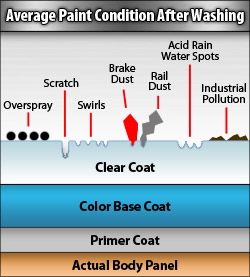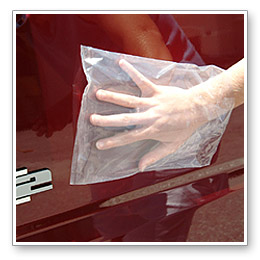Tech Tip
Cleaning with Clay
Reprinted with permission of Autogeek.net.
If Detailing Clay is new to you, you might be thinking, “What is Detailing Clay and what can Detailing Clay do for my car?” The short answer is that Auto Detailing Clay removes from the paint what washing cannot. For the long answer, read on!

Auto Detailing Clay Bar is an engineered resin compound used to remove contaminants from the surface of your car’s paint, glass, fiberglass and metal. Detailing Clay can be natural or synthetic, though most manufacturers utilize synthetic clays.
Auto Detailing Clay is similar to the stuff you played with as a kid, but the clay used for detailing is usually much more elastic, especially in the case of Pinnacle Ultra Poly Auto Detailing Clay Bar. The elasticity gives the detailing clay excellent durability as it is rolled, flattened, smashed and stretched over and over again.
Plus, Detailing Clay is designed to stand up to the kind of contaminants that your childhood clay never had to face, i.e. industrial fallout, rail dust and brake dust. These contaminants pierce paint finishes, glass and metal and remain stuck on your vehicle through rain, car washes, and even polishing. The only way to remove these pollutants is – you guessed it – Detailing Clay.
How Does Auto Detailing Clay Work?
Detailing Clay glides along the surface of your paint and grabs anything that protrudes from the surface. The particle sticks to the clay and is therefore removed from your vehicle. The surface being clayed should always be wet with clay lubricant to prevent loose debris from scratching the vehicle.
Used properly, detailing clay is completely safe and nonabrasive. It’s a much better option than polishing to remove these contaminants because clay doesn’t remove any paint.
 |
 |
There are two different grades of clay currently available to the public. One is a medium-grade Detailing Clay designed to clean the vehicle once or twice a year. This grade of clay removes wax along with anything else on the vehicle. We’re talking CLEAN. Examples are Wolfgang Elastic Poly Clay and McKee’s 37 Universal Detailing Clay.
Your other option is a fine-grade Detailing Clay that’s relatively new to the industry. It’s called Pinnacle Ultra Poly Clay and it’s a favorite of enthusiasts who prefer to clay as often as needed to keep that slick finish. This detailing clay removes everything the medium-grade clay removes and it is gentle enough to use monthly or as needed for spot cleaning. If you’re someone who’s meticulous about clean, shiny paint (and who isn’t?!) you’ll love Pinnacle Ultra Poly Clay.
All Detailing Clay requires the use of a clay lubricant to prevent scratches as you gently rub the clay on the vehicle. Check out our Clay Page. There you will find all of the different clays and their coordinated clay lubricants.
What Does Detailing Clay Remove?
Your vehicle is under constant assault from airborne pollutants. Brake dust, industrial fallout, acid rain deposits and rail dust all can adhere to your vehicle. These contaminants often contain metal particulates, which accounts for the ease with which they penetrate the clear coat to attack the paint below. These contaminants then oxidize, and they allow rust to spread beneath the clear coat. Tiny orange spots today, total paint system failure tomorrow! Detailing Clay removes these contaminants in order to keep the paint healthy and vibrant.
Detailing Clay also removes stubborn sap, tar, and bug remains. Detailing Clay works wonders on glass as well. Try some the next time you’re washing your windows. You’ll be amazed at the results!
Do You Need To Clay?
Chances are, the answer is yes. The surface of your vehicle faces assaults from the environment every time it’s out in the weather. Each road trip brings new insults from roadway debris, exhaust films, and airborne pollution. They will splash, mar, and embed themselves in that beautiful paint job you’ve labored over. Vehicles can accumulate these contaminants any time, any place – even at the dealership.

The Bag Test: There’s a simple test that will indicate whether or not you need to clay. Wash and dry your vehicle, put a plastic sandwich bag over your hand and lightly rub your fingertips over the paint. If it feels gritty or rough, your paint is contaminated.
Use a high quality Detailing Clay bar, like Wolfgang Elastic Poly Clay or Pinnacle Ultra Poly Clay, and a clay lubricant to clean your paint before applying wax or polish.
Waxes and paint sealants will adhere better to clean paint and the shine will be more uniform and vibrant. Sounds like a win-win situation!
To Use Clay:
Auto Detailing Clay is available in 2 to 8 oz. bars. Two ounces is enough to do three or four vehicles. On average, a vehicle will need to be clayed twice a year. At this rate, one 2 oz. clay bar will last you 18 months to 2 years if used on the same vehicle. If you buy clay in an 4 oz. bar, like McKee’s 37 Universal Detailing Clay or BLACKFIRE Poly Clay, cut it in half and keep the unused portions moistened with lubricant in the storage case.
NOTE: To optimize both the quality of your claying and the clay’s useful life, avoid soap and water as a lubricant. They will prematurely deteriorate today’s clay compounds. Use only clay lubricants. A good clay kit, like the The Wolfgang Polishin’ Pal Clay Kit, contain both the Detailing Clay and its corresponding lubricant.
Follow these steps:
1. Wash and dry your vehicle.
2. Spray a small area with clay lubricant, no bigger than 2 square feet.
 |
3. Gently rub the clay bar back and forth across the wet area. It will grab at first. This means that it is pulling contaminants out of the paint. When it glides freely, the paint is clean.
 |
4. Wipe the area with a microfiber towel and use the clay lubricant to remove any clay residue. Rub your fingers across the paint now; it should be as smooth as glass. If it’s not, repeat the process. Reshape the clay bar as needed to expose a clean surface. Keep the clay well-lubricated.
5. Continue these steps until you’ve clayed the entire vehicle. Clay does a marvelous job on glass and chrome, too.
6. Store the clay bar in its original case if possible, or in an airtight plastic bag. Spray it with lubricant to keep it moist. Do not allow the clay to freeze and do not store it in temperatures above 200°F.
7. Always follow claying with a wax or sealant. Clay will removing existing wax and may leave tiny holes where contaminants have been removed. They must be sealed in order to protect the paint from corrosion.
NOTE: Detailing Clay does not remove oxidized paint or fill in blemishes. If your paint is mildly oxidized, clean the paint with clay and then use a polish to remove the oxidized paint. If the oxidation is severe, polish first because the oxidized paint may flake off as you clay and ruin the clay bar. (See our polish how-to.)
